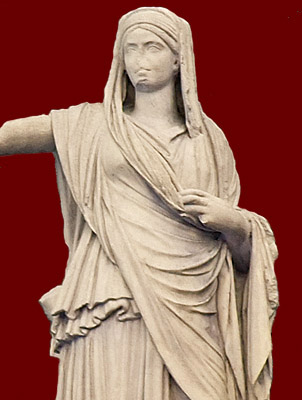
Virgo Vestalis Maxima
Courtyard, Atrium Vestae, 3rd century CE

Postumia was a priestess of the virginal earth deity Vesta, goddess of the hearthfire. We know little more about her than her name -- not her age, her birth family, or her priestly status. Livy briefly mentions that in 420 BCE she was accused of the crime of incestum and went on trial for the loss of her virginity. For a Vestal, chastity was the central tenet of her 30-year term of office as established by Numa Pompilius, the second king of Rome (see Livy, AUC I.20). Whatever his original intent, Numa's requirement of virginity made the Vestals unique citizens of the State; belonging by law to no individual family, they were neither matronae nor virgines, in the sense of being prospective brides. Since the purity of the Vestals was believed to be linked with the integrity and safety of Rome, Vestals enjoyed distinctive honors for performing their sacred office well but were punished severely for dereliction of duty. Vestals could be disciplined, even by whipping, by their guardian, the Pontifex Maximus, for transgressions such as disobedience or allowing the sacred fire in the Temple of Vesta to die out. Upon the suspicion of crimen incesti, Vestals were removed from their sacred duties and were brought before a court of the full Pontifical College for investigation of the charge. Conviction resulted in punishment by living burial, which was a death reserved for unchaste Vestal Virgins who were considered to have threatened the pax deorum, the harmony or accord between the Roman people and their gods. While there were doubtless transgressions by individual Vestals of their vow of sexual purity (castitas) during the almost 1,000 years of Vestal history, scholars have observed that many of these charges were made during periods of military crisis, evil omens (prodigia) or class struggle, and thus suspect that some accused Vestals may have been innocent, scapegoats to public fear or pawns in plebeian-patrician conflict. In at least one case, judgment against Vestals contributed to an ancestor's gloria, as illustrated by this Republican denarius, which contains on its obverse the head of the goddess Libertas. Coined by Quintus Cassius Longinus, moneyer of the Roman mint in 55 BCE, it memorializes the independent judicial authority exercised in 113 BCE in a special investigation led by his ancestor Lucius Cassius Longinus Ravilla, a plebeian, who condemned two of the three Vestals accused of incestum after they had been absolved by the Pontifical court under the Pontifex Maximus Lucius Caecilius Metellus Dalmaticus, a patrician. The reverse of the coin displays the judge's sella curulis in the Temple of Vesta, flanked by a voting urn and the letters AC (the votes Absolvo and Condemno). While a few condemned Vestals committed suicide, most suffered the public infamy and terrible expiation of the charge (see Ovid, Fasti 6.457-460). Dressed in funereal garb, they were carried gagged and bound in a closed litter, followed by mourning family and friends, to the campus sceleratus near the Porta Collina on the Quirinal Hill. There the Pontifex Maximus removed them from the litter and their bonds and sent them down a ladder into an underground room furnished with a bed, blanket, lighted lamp, water, bread, milk and oil, sufficient sustenance to keep the State from blame for their death after the ladder was removed and the entrance filled (see Plutarch, Numa 10.4-7). In the passage below from his annalist history Ab Urbe Condita, Livy devotes two sentences in his narration of the difficult military campaigns and electoral tensions of 420 BCE to a public charge against one of the Vestal Virgins. Unlike the tragic outcomes on record of other early accusations of incestum against Vestals (e.g., Oppia in 484 BCE, Orbinia in 472 BCE, Minucia in 337 BCE), Postumia's trial ends on a rather humorous note.
For additional Companion texts on the Vestals, see Occia, from Tacitus'Annales, Virgo Vestae, from Aulus Gellius' Noctes Atticae, and Monumental Inscriptions for Virgines Vestales Maximae. For further information on the cult, consult Parker (2004), Staples (1998), Takacs (2008), and Wildfang (2006) in the Bibliography.
(1) Eodem anno Postumia virgo vestalis de incestu causam dixit, crimine innoxia, ab suspicione propter cultum amoeniorem ingeniumque liberius quam virginem decet parum abhorrens.
Eam ampliatam, deinde absolutam pro collegii sententia
![]() pontifex maximus abstinere iocis colique sancte potius quam scite iussit.
pontifex maximus abstinere iocis colique sancte potius quam scite iussit.
Click on the underlined words for translation aids and commentary, which will appear in a small window. Click on the icon link![]() to the right of the line for related images and information.
to the right of the line for related images and information.